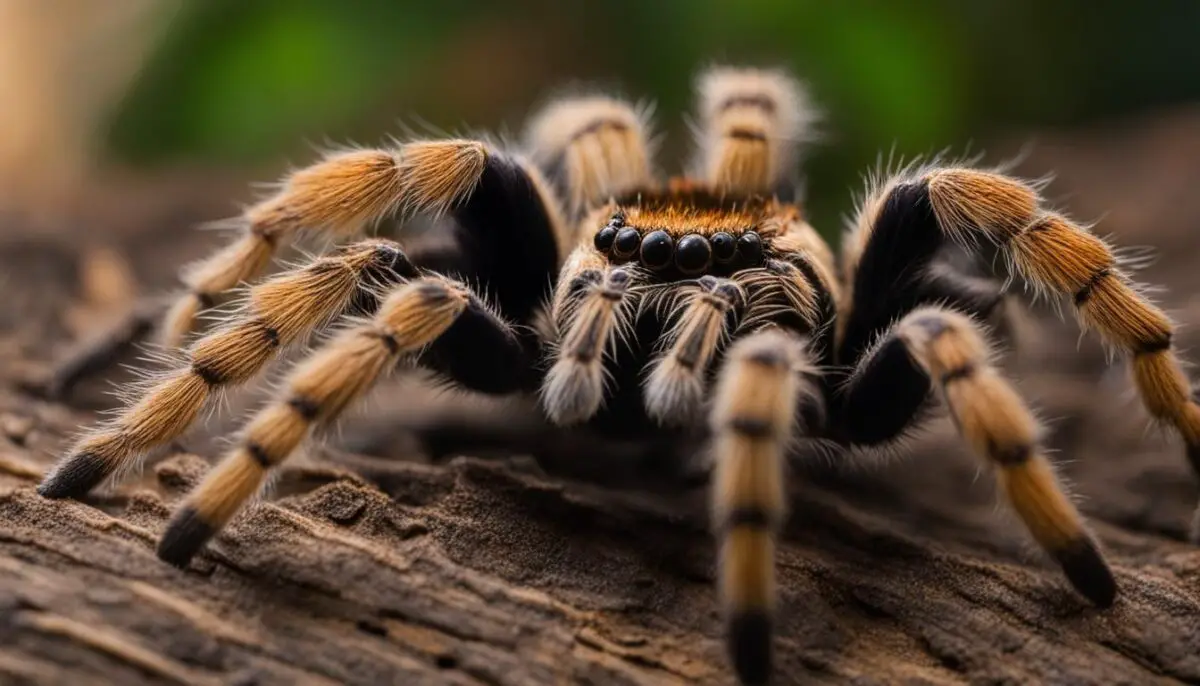Are you curious about why tarantulas are considered the best pets? In this article, we will explore the various benefits of owning tarantulas and why they make fascinating companions. From their low-maintenance care requirements to their unique characteristics and behaviors, tarantulas offer a truly captivating and rewarding pet ownership experience.
- Tarantulas are low-maintenance pets that require minimal attention and care.
- They exhibit fascinating behaviors and possess unique characteristics that make them stand out as pets.
- Contrary to popular belief, tarantulas can be great pets for beginners.
- Tarantulas’ vibrant colors have been linked to mating rituals.
- Owning a tarantula can help individuals overcome arachnophobia.
Why Tarantulas Are The Best Pets
Low-Maintenance Pet Care
Tarantulas make excellent pets for those seeking a low-maintenance companion. Unlike dogs or cats, tarantulas do not require daily walks or constant attention. They are content being left alone in their proper enclosures, making them ideal for busy individuals or those who prefer pets that require less direct care. why tarantulas are the best pets
Feeding tarantulas is also a straightforward task. These creatures have slow metabolisms and primarily feed on insects. As a result, they only need to be fed once or twice a week, making them a convenient choice for pet owners with busy schedules. tarantulas as pets
Tarantulas have specific habitat needs that can be easily met with the right enclosure and conditions. Providing them with a suitable environment ensures their well-being and minimizes the effort required for their care.
Table: Comparison of Tarantula Care Requirements
| Care Requirements | Tarantulas | Dogs | Cats |
|---|---|---|---|
| Feeding Frequency | Once or twice a week | Daily | Daily |
| Exercise Needs | Minimal | Regular walks | Independent |
| Grooming | None | Regular grooming | Regular grooming |
| Time Commitment | Low | High | Medium |
As shown in the table above, tarantulas require significantly less time and effort compared to traditional pets such as dogs and cats. Their low-maintenance nature allows pet owners to enjoy the companionship of a fascinating creature without compromising their busy lifestyles. tarantula pet care
Fascinating Behavior and Unique Characteristics
Tarantulas exhibit fascinating behavior and possess unique characteristics that make them stand out as pets. These creatures are skilled hunters, using their strong legs and sharp fangs to capture prey. Some species can spin intricate webs, while others prefer to burrow in substrate. Witnessing a tarantula hunting or constructing its web is a captivating experience that allows pet owners to appreciate the natural instincts and survival strategies of these fascinating creatures. tarantulas as low-maintenance pets
One of the most remarkable behaviors of tarantulas is the molting process. Tarantulas periodically shed their old exoskeleton, enabling them to grow. During the molting process, the tarantula becomes vulnerable and may appear lethargic or unresponsive. This natural phenomenon provides owners with a unique opportunity to observe the delicate and intricate process of a tarantula shedding its skin, revealing a larger and more vibrant version of itself.
In addition to their captivating behavior, tarantulas also come in a variety of colors and patterns. Some species boast vibrant hues of blue, green, or orange, while others display intricate patterns and markings. These eye-catching colors and unique patterns make tarantulas visually appealing pets that can add a touch of natural beauty to any home.

In summary, tarantulas offer pet owners the opportunity to witness fascinating behavior and appreciate the unique characteristics of these creatures. From their hunting techniques and web-building skills to the molting process and stunning colors, tarantulas are truly captivating pets that provide a glimpse into the wonders of the natural world. tarantulas as unique pets
Tarantulas Are Beginner-Friendly
Contrary to popular belief, tarantulas can be great pets for beginners. Many tarantula species are hardy and relatively forgiving in terms of care. Beginner-friendly species, such as the Chilean Rose tarantula, are docile and have mild venom, making them safer for novice owners. Additionally, tarantulas have simple care requirements, and there is a wealth of information and resources available to guide new owners through the process of pet ownership. With proper research and preparation, even beginners can successfully care for and enjoy the companionship of a tarantula. reasons to have tarantulas as pets
One of the advantages of owning a tarantula as a beginner pet is their low-maintenance nature. They don’t require daily walks or constant attention like traditional pets. Tarantulas primarily need a suitable enclosure that meets their specific habitat needs, and they only need to be fed once or twice a week due to their slow metabolisms. They are also solitary creatures that do not require social interaction and are content being left alone. This makes them ideal for individuals with busy lifestyles or those who prefer pets that require less direct care.
Additionally, tarantulas have gained popularity as beginner pets due to their fascinating behavior and unique characteristics. They are skilled hunters and some species can spin intricate webs or prefer burrowing. Witnessing the molting process, where tarantulas shed their old exoskeleton to grow, is a remarkable experience. Tarantulas also come in a variety of colors and patterns, adding to their visual appeal. These captivating behaviors and characteristics make tarantulas fascinating pets to observe and learn from. tarantula pet ownership
Overall, tarantulas offer a rewarding and manageable pet ownership experience for beginners. With their low-maintenance care requirements, captivating behavior, and unique characteristics, tarantulas provide an opportunity for individuals to connect with nature, explore the mysteries of the animal kingdom, and learn more about these remarkable creatures.
| Advantages of Tarantulas as Beginner Pets | Why Tarantulas Are Great for Beginners |
|---|---|
| Hardy and forgiving species | Low-maintenance pets |
| Docile and mild venom | Simple care requirements |
| Abundance of information and resources | Opportunity to learn about tarantulas |
The Mystery of Vibrant Colors
Tarantulas are known for their vibrant colors, particularly shades of blue and green. A recent study conducted by researchers from Yale-NUS College and Carnegie Mellon University revealed that tarantulas are not color-blind as previously believed. Tarantulas have light-sensitive proteins called opsins in their eyes, similar to day-active spiders with color vision. This discovery suggests that tarantulas use their distinct blue and green markings to attract and communicate with potential mates. Furthermore, the study found that the blue coloring is not linked to survival or hunting but is likely associated with mating.

The Evolution of Tarantula Coloration
A key aspect of tarantula history is the evolution of their vibrant colors, particularly the striking blues found in some species. The presence of blue coloration is not uniform across all tarantulas, indicating a complex interplay between genetics, environmental factors, and selective pressures. Future studies seek to unravel the genetic basis of color variation in tarantulas and understand how it contributes to their survival and reproductive success.
Overcoming Arachnophobia Through Tarantula Ownership
Many people suffer from arachnophobia, the fear of spiders. However, owning a tarantula can actually help individuals overcome this fear and develop a newfound appreciation for these fascinating creatures. Tarantulas are often seen as cute and fluffy pets, with their calm demeanor and unique characteristics. By observing and interacting with tarantulas, individuals can gradually dispel their fears and phobias associated with spiders.
Through regular exposure to tarantulas, individuals can develop a deeper understanding of these creatures and recognize that they are not as threatening as they may have initially believed. The low-maintenance care requirements of tarantulas also make them an ideal choice for those looking to overcome their fear of spiders. With proper research and guidance, individuals can learn to confidently care for and handle their tarantula pets, further aiding in their journey to conquer their arachnophobia.
“Having a tarantula as a pet has truly changed my perspective on spiders,” says Jane, a former arachnophobia sufferer. “I used to be terrified of spiders, but owning a tarantula has allowed me to confront my fears and realize that they are actually fascinating creatures. Now, I can appreciate their beauty and uniqueness.”
It is important to note that overcoming arachnophobia is a personal journey, and it may take time and patience. However, tarantulas have proven to be effective companions in helping individuals confront and overcome their fears. By providing a safe and controlled environment for individuals to interact with these gentle creatures, tarantulas can help alleviate fear and foster a positive relationship with spiders.
Table: Comparing Tarantula Ownership Benefits
| Benefits | Tarantula Ownership | Other Pets |
|---|---|---|
| Overcoming Arachnophobia | ✓ | – |
| Low-Maintenance | ✓ | – |
| Unique Characteristics | ✓ | – |
| Minimal Social Interaction | ✓ | – |
| Visual Appeal | ✓ | – |
Table: Comparing the benefits of tarantula ownership with other pets.
The Unconventional Pet Owner
Owning a tarantula reflects an individual’s preference for unconventional pets. While many people opt for cats or dogs, some seek more unique companionship. Tarantulas, along with other exotic animals, provide a sense of excitement and intrigue. They offer pet owners the opportunity to engage with lesser-known species and explore the fascinating world of exotic pets. For those who value individuality and enjoy the responsibility of caring for unconventional pets, tarantulas offer an ideal choice.
Not everyone is drawn to traditional pets like dogs or cats. Some individuals crave a pet that stands out from the crowd and sparks curiosity. Tarantulas certainly fit the bill as unconventional pets. Their striking appearance, intriguing behaviors, and unique care requirements make them a captivating choice for those looking to step outside the mainstream.
While tarantulas may not be the first choice for everyone, they can provide a rewarding and fulfilling pet ownership experience. The ability to connect with an unconventional creature and learn about its unique habits and needs is a valuable and enriching endeavor. For those seeking a pet that challenges expectations and opens doors to new experiences, tarantulas are the perfect choice.

Exploring the World of Exotic Pets
Owning a tarantula allows individuals to delve into the fascinating world of exotic pets. These unconventional creatures offer a glimpse into the diversity of life on our planet and provide a chance to interact with species that are not typically seen as pets. By embracing the unconventional, pet owners can broaden their horizons and gain a deeper appreciation for the wonders of the natural world.
Sharing the Fascination on Social Media
Tarantula owners have harnessed the power of social media platforms to connect and share their fascination with these captivating creatures. Platforms like Instagram, Facebook, and Tumblr have become virtual hubs for tarantula enthusiasts, providing a space to showcase their beloved pets and engage with a like-minded community. Through these platforms, tarantula owners can document and share the unique behaviors, vibrant colors, and charming antics of their pet tarantulas, sparking curiosity and dispelling common misconceptions about these misunderstood creatures.
“Social media allows me to share the beauty and wonder of tarantulas with a wider audience,” says Cassandra Tainsh, a tarantula enthusiast with a significant following on Instagram. “I love capturing their unique personalities and showcasing their natural behaviors. It’s amazing to see how many people are fascinated by these creatures once they get a glimpse into their world.”
These social media accounts not only entertain and educate audiences but also contribute to changing perceptions surrounding tarantulas. By showcasing the natural beauty and diverse characteristics of tarantulas, these posts challenge the common stereotypes and foster a greater appreciation for these remarkable creatures. From close-up macro shots that highlight intricate patterns to videos capturing molting or feeding processes, tarantula owners are able to offer a window into the captivating world of tarantulas through social media.
The Future of Tarantula Care and Research
As our fascination with tarantulas continues to grow, so does the need for further research and innovation in the field of tarantula care. Ongoing studies are incorporating behavioral elements to gain a deeper understanding of tarantula behavior and their perception of vibrant colors in different light environments. These studies aim to shed light on the intricate mating rituals, ecology, and overall well-being of these captivating creatures.
Future research projects will delve deeper into the mysteries surrounding tarantula behavior, including their feeding techniques, burrowing habits, and molting process. By unraveling these secrets, we can provide tarantulas with the optimal care they require to thrive in captivity. Additionally, research into the breeding and reproductive habits of tarantulas will contribute to the creation of successful breeding programs and conservation efforts, ensuring the preservation of these incredible species for generations to come.
Furthermore, the insights gained from future studies will inform the development of improved care practices for tarantulas, including enclosure design, nutritional requirements, and overall well-being. By understanding their natural behaviors and unique needs, we can provide an enriched environment that allows tarantulas to exhibit their natural behaviors and thrive as pets.
Table: Future Research Areas for Tarantula Care and Research
| Research Area | Purpose |
|---|---|
| Behavioral Studies | Gain a deeper understanding of tarantula behavior, feeding techniques, burrowing habits, and molting process. |
| Mating Rituals | Investigate the intricacies of tarantula mating rituals to inform successful breeding programs. |
| Ecology | Explore the ecological role of tarantulas in their natural habitats and their influence on local ecosystems. |
| Care Practices | Develop improved care practices, including enclosure design, nutritional requirements, and overall well-being. |
| Conservation Efforts | Contribute to conservation efforts to ensure the preservation of tarantula species and their natural habitats. |
By investing in future research and innovation, we can continue to enhance our understanding of tarantulas and provide the best possible care for these extraordinary pets. With each new discovery, we deepen our connection with these fascinating creatures and pave the way for a future where tarantulas thrive both in the wild and in our homes.

Conclusion
In conclusion, tarantulas are undeniably the best pets for a multitude of reasons. Their low-maintenance care requirements make them ideal companions, especially for those with busy lifestyles or a preference for pets that require less direct care. Additionally, tarantulas possess fascinating behaviors and unique characteristics that captivate both beginners and experienced pet owners.
Not only are tarantulas beginner-friendly, but they also offer an opportunity to overcome arachnophobia. By providing a cute and fluffy alternative to traditional spiders, tarantulas can gradually dispel fears and phobias associated with spiders, fostering a deeper understanding and appreciation for these remarkable creatures.
With their vibrant colors and intriguing history, tarantulas add excitement and intrigue to the world of pet ownership. Social media platforms have become a hub for tarantula enthusiasts to share their fascination, dispel myths, and educate others about the joys of owning these unique pets.
As research and innovation continue to expand our understanding of tarantulas, the future holds promise for improved care practices and conservation efforts. By adding a tarantula to your family, you can embark on a remarkable journey filled with natural wonders, appreciation for the animal kingdom, and the joy of having an extraordinary and captivating pet.
FAQ
Are tarantulas easy to take care of?
Yes, tarantulas are low-maintenance pets that require minimal attention and care.
How often do tarantulas need to be fed?
Tarantulas only need to be fed once or twice a week due to their slow metabolisms.
Do tarantulas require social interaction?
No, tarantulas are content being left alone and do not require social interaction.
Are tarantulas a good pet choice for beginners?
Yes, many tarantula species are beginner-friendly and have simple care requirements.
Do tarantulas have vibrant colors?
Yes, tarantulas come in a variety of colors, including shades of blue and green.
Why do tarantulas have vibrant colors?
Tarantulas use their distinct blue and green markings to attract and communicate with potential mates.
How long have tarantulas had vibrant colors?
Tarantulas have had vibrant colors for millions of years, according to comparative phylogenetic analyses.
Can owning a tarantula help with arachnophobia?
Yes, many individuals have found comfort and reassurance in owning a tarantula and gradually overcoming their fear of spiders.
Are tarantulas considered unconventional pets?
Yes, tarantulas are often chosen by individuals who prefer more unique and unconventional pets.
Are there social media accounts dedicated to tarantulas?
Yes, platforms like Instagram, Facebook, and Tumblr feature accounts showcasing the behavior and antics of pet tarantulas.
What does the future hold for tarantula care and research?
Future studies aim to expand our understanding of tarantula behavior, mating rituals, and ecology, leading to improved care practices and conservation efforts.


You made some good points there. I did a search on the subject matter and found most guys will agree with your website.